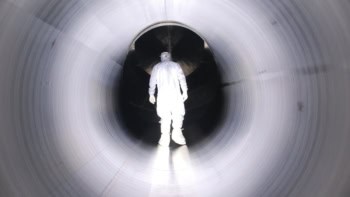An international team of physicists has made the first theoretical estimation of the size of CP violation, a parameter that describes the difference between matter and antimatter. Their calculation matches experimental data, which suggests such data are typical of a fundamental framework and do not expose any underlying issues in the Standard Model of particle physics.
Besides energy, physicists think “stuff” comes in two forms: matter and antimatter. While most physicists believe that the Big Bang created equal amounts of both, the universe today is almost exclusively composed of matter and this discrepancy implies there should be a difference in behaviour between matter and antimatter. In the Standard Model of particle physics this is incorporated as a phenomenon known as charge–parity or “CP” violation.
CP violation was discovered experimentally in 1964 when Jim Cronin and Val Fitch at Princeton University found that the CP quantum number changed sign during the decay of kaons. A decade later Makoto Kobayashi and Toshihide Maskawa of Nagoya University explained the result in the 3 x 3 “CKM” matrix, which describes how the strange quark and down quark inside a kaon can switch to and fro into their antiparticles and, in doing so, occasionally break CP symmetry. Both groups received separate Nobel prizes for their efforts.
The extent of CP violation in the CKM matrix is given by the so-called Jarlskog parameter, J, which can have a maximum value of about 0.1. Naively one might expect J to take values somewhere in the middle between zero and 0.1, but in experiments it turns out to be very small — about 3 x 10-5 — and this raises the question of whether there is some unknown factor making it that way.
Cosmologists to the rescue
Now cosmologists Gary Gibbons and Steffen Gielen at the University of Cambridge, Chris Pope at Texas A&M University and Neil Turok the Perimeter Institute have calculated that such a low value of J is to be expected after all.
Turok’s group has used statistical arguments based on “randomness” to investigate the shape of the geometry of the CKM matrix. They found when the masses of quarks in the matrix were left unconstrained J came out to be much larger than experiments indicate, but when the known values of quarks were inputted J came out close to its observed value. They have published their results in Physical Review Letters and Physical Review D.
“What this work explains is that the actual value of the CP violation that’s measured is a typical value,” says Turok.
Further potential
Different variations on the researchers’ study could have important consequences. A similar analysis for a 4 x 4 matrix, for example, would reveal the likelihood of there being a fourth, much heavier generation of quarks in addition to the three presently known. Also, an analysis on neutrinos could suggest whether these light particles should also exhibit CP-violating processes.
I would be surprised and disappointed if randomness were the whole story Frank Wilczek, Massachusetts Institute of Technology
Frank Wilczek, a particle physicist at the Massachusetts Institute of Technology, who shared the Nobel Prize for Physics in 2004 for his work on the strong interaction, suspects there may be more to CP violation, however. He notes that the overall phase of the matrix is known to be much smaller than could be explained by “statistical fluke”, and thinks there seem to be patterns in the matrices for quarks and leptons that hint of more expansive underlying theories. Moreover, he points out a certain circular reasoning in the researchers’ logic in that they have had to assume the masses of quarks and their associated hierarchy.
“I think ‘randomness’ in the [CKM] matrix is a sensible thing to explore, and might form a baseline against which to test alternative ideas based on symmetry or dynamics,” he adds. “On the other hand I would be surprised and disappointed if randomness were the whole story.”



